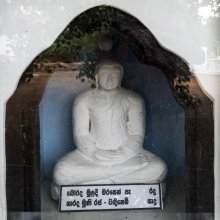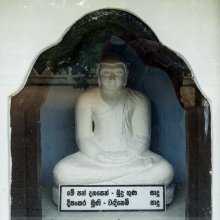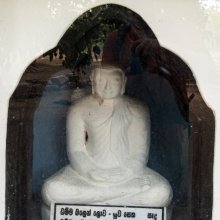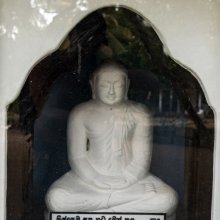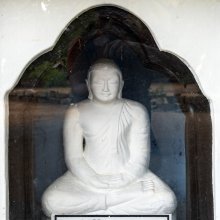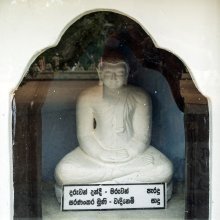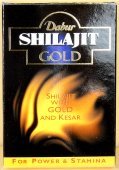Muni, Muṉi: 40 definitions
Introduction:
Muni means something in Buddhism, Pali, Hinduism, Sanskrit, Jainism, Prakrit, the history of ancient India, Marathi, Hindi, biology, Tamil. If you want to know the exact meaning, history, etymology or English translation of this term then check out the descriptions on this page. Add your comment or reference to a book if you want to contribute to this summary article.
Images (photo gallery)
(+24 more images available)
In Hinduism
Ayurveda (science of life)
Cikitsa (natural therapy and treatment for medical conditions)
Source: Wisdom Library: Ayurveda: CikitsaMuni(मुनि):—Another name for Agastya (Sesbania grandiflora), a species of medicinal plant and used in the treatment of fever (jvara), as described in the Jvaracikitsā (or “the treatment of fever”) which is part of the 7th-century Mādhavacikitsā, a Sanskrit classical work on Āyurveda.

Āyurveda (आयुर्वेद, ayurveda) is a branch of Indian science dealing with medicine, herbalism, taxology, anatomy, surgery, alchemy and related topics. Traditional practice of Āyurveda in ancient India dates back to at least the first millenium BC. Literature is commonly written in Sanskrit using various poetic metres.
Natyashastra (theatrics and dramaturgy)
Source: Wisdom Library: Nāṭya-śāstra1) Muni (मुनि) is the Sanskrit name of one of Bharata’s sons, mentioned in the Nāṭyaśāstra 1.26-33. After Brahmā created the Nāṭyaveda (nāṭyaśāstra), he ordered Bharata to teach the science to his (one hundred) sons. Bharata thus learned the Nāṭyaveda from Brahmā, and then made his sons study and learn its proper application. After their study, Bharata assigned his sons (eg., Muni) various roles suitable to them.
2) Muni (मुनि) is the Sanskrit name for “sages”, to be worshipped during raṅgapūjā, according to the Nāṭyaśāstra 3.1-8. Accordingly, the master of the dramatic art who has been initiated for the purpose shall consecrate the playhouse after he has made obeisance (e.g., to Munis).

Natyashastra (नाट्यशास्त्र, nāṭyaśāstra) refers to both the ancient Indian tradition (shastra) of performing arts, (natya—theatrics, drama, dance, music), as well as the name of a Sanskrit work dealing with these subjects. It also teaches the rules for composing Dramatic plays (nataka), construction and performance of Theater, and Poetic works (kavya).
Purana and Itihasa (epic history)
Source: Wisdom Library: Varāha-purāṇaMuni (मुनि).—One of the seven sons of Dyutimān, who was a son of Priyavrata, according to the Varāhapurāṇa chapter 74. Priyavrata was a son of Svāyambhuva Manu, who was created by Brahmā, who was in turn created by Nārāyaṇa, the unknowable all-pervasive primordial being.
Source: archive.org: Puranic Encyclopedia1) Muni (मुनि).—The mother of the Yakṣas. It is stated that Kaśyapaprajāpati begot of his wife Muni, the Yakṣas. (Chapter 19, Agni Purāṇa). The Gandharvas also were born of Muni. She gave birth to sixteen Gandharvas of which the first was named Bhīmasena. (Śloka 42, Chapter 65, Ādi Parva).
2) Muni (मुनि).—Son of a Vasu named Ahar (i.e. Ahaḥ) (Śloka 23, Chapter 66, Ādi Parva).
3) Muni (मुनि).—Son of Kuru of the Pūru line of kings. Kuru begot of his wife Vāhinī five sons named Aśvavān, Abhiṣyanta, Caitraratha, Janamejaya and Muni. (Śloka 50, Chapter 94, Ādi Parva).
4) Muni (मुनि).—One of the seven sons of a King named Dyutimān. (Mārkaṇḍeya Purāṇa 5. 24).
Source: archive.org: Shiva Purana - English TranslationMuni (मुनि) refers to “sages”, according to the Śivapurāṇa 2.3.4.—Accordingly, as Umā (Durgā/Satī) spoke to the Gods:—“[...] Hear further, O Viṣṇu, O Brahmā, O sages [i.e., muni] and O gods, the divine sports of the supreme lord Śiva, that protect the universe. Oppressed by the pangs of bereavement He wreathed a garland of my bones. Although He is the sole enlightened god He did not get peace anywhere. Like a non-god, like a helpless creature he roamed about here and there and cried aloud. The lord Himself could not distinguish between the proper and the improper. [...]”.
Source: Cologne Digital Sanskrit Dictionaries: The Purana Index1a) Muni (मुनि).—A daughter of Dakṣa and one of the 13 wives of Kaśyapa; a mother goddess; mother of groups of munis and sages, Apsaras and Gandharvas;1 given to Gandha śīlā.2
- 1) Bhāgavata-purāṇa VI. 6. 26-7; Brahmāṇḍa-purāṇa III. 3. 56; Matsya-purāṇa 6. 2, 45; 146. 19; 171. 29, 60; Vāyu-purāṇa 66. 55.
- 2) Brahmāṇḍa-purāṇa III. 7. 466.
1b) A son of Dyutimān, after whom came the Maunideśam in Krauncadvīpa.*
- * Brahmāṇḍa-purāṇa II. 14. 23, 26; Vāyu-purāṇa 33. 21, 23. Viṣṇu-purāṇa II. 4. 48.
1c) A god of Prasūta group.*
- * Brahmāṇḍa-purāṇa II. 36. 71.
1d) A son of Vaidya.*
- * Brahmāṇḍa-purāṇa III. 59. 7. Vāyu-purāṇa 84. 7.
1e) A son of Pradyumna and father of Ūrjavaha.*
- * Brahmāṇḍa-purāṇa III. 64. 20; Vāyu-purāṇa 89. 19.
1f) One of the twenty Amitābha gods.*
- * Brahmāṇḍa-purāṇa IV. 1. 17; Vāyu-purāṇa 100. 17.
1g) A sage of the Raivata epoch;1 a Viśvedeva.2
1h) One of the wives of Kaśyapa; gave birth to Apsarasas.*
- * Viṣṇu-purāṇa I. 15. 125; 21. 25.
1i) Those who delight in the ātman, after many births, and renounce even the region of Brahmā; realise the Supreme Spirit by shaking off the three dreamy stages— bhāvādvaita, kriyādvaita, and dravyādvaita.*
- * Bhāgavata-purāṇa III. 27. 27; VII. 15. 62-5; X. 2. 25.
Muni (मुनि) is a name mentioned in the Mahābhārata (cf. I.89.44) and represents one of the many proper names used for people and places. Note: The Mahābhārata (mentioning Muni) is a Sanskrit epic poem consisting of 100,000 ślokas (metrical verses) and is over 2000 years old.
Muni also refers to the name of a Lady mentioned in the Mahābhārata (cf. I.59.12, I.65, I.60.22).
Source: Shodhganga: The saurapurana - a critical studyMuni (मुनि) refers to one of thirteen of Dakṣa’s sixty daughters given to Kaśyapa in marriage, according to one account of Vaṃśa (‘genealogical description’) of the 10th century Saurapurāṇa: one of the various Upapurāṇas depicting Śaivism.—Accordingly, Dakṣa gets married to Asikni, the daughter of Prajāpati Viraṇa and begot sixty daughters. [He gave thirteen daughters to Kaśyapa]. Kaśyapa’s thirteen wives are Aditi, Diti, Danu, Ariṣṭā, Surasā, Svadhā, Surabhi, Vinatā, Tamrā, Krodhavasā, Irā and Muni.

The Purana (पुराण, purāṇas) refers to Sanskrit literature preserving ancient India’s vast cultural history, including historical legends, religious ceremonies, various arts and sciences. The eighteen mahapuranas total over 400,000 shlokas (metrical couplets) and date to at least several centuries BCE.
Vaishnavism (Vaishava dharma)
Source: Pure Bhakti: Bhagavad-gita (4th edition)Muni (मुनि) refers to “(1) Great sage (2) One who endeavours to approach the Absolute Truth by dint of mental prowess”. (cf. Glossary page from Śrīmad-Bhagavad-Gītā).
Source: Pure Bhakti: Bhajana-rahasya - 2nd EditionMuni (मुनि) refers to:—A sage, ascetic, spiritual scholar or self-realised soul. (cf. Glossary page from Bhajana-Rahasya).
Source: Pure Bhakti: Brhad BhagavatamrtamMuni (मुनि) refers to:—A sage. (cf. Glossary page from Śrī Bṛhad-bhāgavatāmṛta).

Vaishnava (वैष्णव, vaiṣṇava) or vaishnavism (vaiṣṇavism) represents a tradition of Hinduism worshipping Vishnu as the supreme Lord. Similar to the Shaktism and Shaivism traditions, Vaishnavism also developed as an individual movement, famous for its exposition of the dashavatara (‘ten avatars of Vishnu’).
Ganitashastra (Mathematics and Algebra)
Source: archive.org: Hindu MathematicsMuni (मुनि) represents the number 7 (seven) in the “word-numeral system” (bhūtasaṃkhyā), which was used in Sanskrit texts dealing with astronomy, mathematics, metrics, as well as in the dates of inscriptions and manuscripts in ancient Indian literature.—A system of expressing numbers by means of words arranged as in the place-value notation was developed and perfected in India in the early centuries of the Christian era. In this system the numerals [e.g., 7—muni] are expressed by names of things, beings or concepts, which, naturally or in accordance with the teaching of the Śāstras, connote numbers.

Ganitashastra (शिल्पशास्त्र, gaṇitaśāstra) refers to the ancient Indian science of mathematics, algebra, number theory, arithmetic, etc. Closely allied with astronomy, both were commonly taught and studied in universities, even since the 1st millennium BCE. Ganita-shastra also includes ritualistic math-books such as the Shulba-sutras.
In Buddhism
Tibetan Buddhism (Vajrayana or tantric Buddhism)
Source: Wisdom Library: Tibetan BuddhismMuni (मुनि) refers to one of the various Ṛṣis (sages) and Mahārṣis (great sages) mentioned as attending the teachings in the 6th century Mañjuśrīmūlakalpa: one of the largest Kriyā Tantras devoted to Mañjuśrī (the Bodhisattva of wisdom) representing an encyclopedia of knowledge primarily concerned with ritualistic elements in Buddhism. The teachings in this text originate from Mañjuśrī and were taught to and by Buddha Śākyamuni in the presence of a large audience (including Muni).

Tibetan Buddhism includes schools such as Nyingma, Kadampa, Kagyu and Gelug. Their primary canon of literature is divided in two broad categories: The Kangyur, which consists of Buddha’s words, and the Tengyur, which includes commentaries from various sources. Esotericism and tantra techniques (vajrayāna) are collected indepently.
Mahayana (major branch of Buddhism)
Source: academia.edu: A Study and Translation of the GaganagañjaparipṛcchāMuni (मुनि) refers to a “Sage”, according to the Gaganagañjaparipṛcchā: the eighth chapter of the Mahāsaṃnipāta (a collection of Mahāyāna Buddhist Sūtras).—Accordingly: “[...] After that, by those magically conjured-up beings, during seven days, the women were brought to maturity, in the way that they attained the stage of not falling back from the supreme and perfect awakening. Then the five hundred widows, having come to the Bodhisatva Gaganagañja, uttered these verses: ‘[...] (122) The Sage (muni), the highest leader, predicted for them: In the future, when you completed your practice, you will become supreme conquerors, the well-gone ones called Suvinīta’ [...]”.

Mahayana (महायान, mahāyāna) is a major branch of Buddhism focusing on the path of a Bodhisattva (spiritual aspirants/ enlightened beings). Extant literature is vast and primarely composed in the Sanskrit language. There are many sūtras of which some of the earliest are the various Prajñāpāramitā sūtras.
In Jainism
General definition (in Jainism)
Source: archive.org: Jaina YogaMuni (मुनि) refers to a type of Bhikṣu: the fourth of the four stages of a layman (āśrama) according to Cāmuṇḍarāya (940–989 A.D.) in his Caritra-sāra. Muni refers to a monk who possesses supernatural knowledge (avadhi-jñāna, manaḥ-paryaya-jñāna and kevala-jñāna)
Cāmuṇḍarāya, who was a Digambara Jain, has taken over the Hindu concept of the four āśramas, which, following Jinasena, he terms brahmacārin, gṛhastha, vānaprastha, and bhikṣu (e.g., Muni).
Source: The University of Sydney: A study of the Twelve ReflectionsMuni (मुनि) (Cf. Jñānin) refers to “mendicants”, according to the 11th century Jñānārṇava, a treatise on Jain Yoga in roughly 2200 Sanskrit verses composed by Śubhacandra.—Accordingly, “Further, for the complete attainment of the desire for liberation, non-attachment, restraint and tranquillity, those [twelve reflections] are tied to the post of the mind by mendicants (muni) desiring liberation”.
Synonyms: Jñānin.
Source: academia.edu: Tessitori Collection IMuni (मुनि) or Munipati is the name of a monk, according to the Munipaticaritrasāroddhāra (narrating stories from Jain literature), which is included in the collection of manuscripts at the ‘Vincenzo Joppi’ library, collected by Luigi Pio Tessitori during his visit to Rajasthan between 1914 and 1919.—Background story:—Muni-pati as a monk was practising kāyotsarga and was almost burnt alive accidentally. The merchant Kuñcika took him to his house and restored his body with the help of a special oil. The monk stayed there for the rainy-season. Kuñcika, who was afraid of his son, deposited some money in the monks’ lodging. The son saw this and stole the money, but Kuñcika suspected the monk and accused him of ungratefulness. Thus both started to exchange stories on ungratefulness or lie.

Jainism is an Indian religion of Dharma whose doctrine revolves around harmlessness (ahimsa) towards every living being. The two major branches (Digambara and Svetambara) of Jainism stimulate self-control (or, shramana, ‘self-reliance’) and spiritual development through a path of peace for the soul to progess to the ultimate goal.
India history and geography
Source: Cologne Digital Sanskrit Dictionaries: Indian Epigraphical GlossaryMuni.—(SII 1; IA 30; LL), a Jain monk. (IE 7-1-2), ‘seven’. Note: muni is defined in the “Indian epigraphical glossary” as it can be found on ancient inscriptions commonly written in Sanskrit, Prakrit or Dravidian languages.
Source: Shodhganga: A translation of Jhaverchand Meghanis non translated folk talesMuni refers to “A sage, a saint or an ascetic”.—It is defined in the glossary attached to the study dealing with Gujarat Folk tales composed by Gujarati poet Jhaverchand Meghani (1896-1947)

The history of India traces the identification of countries, villages, towns and other regions of India, as well as mythology, zoology, royal dynasties, rulers, tribes, local festivities and traditions and regional languages. Ancient India enjoyed religious freedom and encourages the path of Dharma, a concept common to Buddhism, Hinduism, and Jainism.
Biology (plants and animals)
Source: Wisdom Library: Local Names of Plants and DrugsMuni in the Tamil language is the name of a plant identified with Sesbania grandiflora (L.)Pers. from the Fabaceae (Pea) family having the following synonyms: Sesban coccinea, Agati grandiflora, Coronilla grandiflora. For the possible medicinal usage of muni, you can check this page for potential sources and references, although be aware that any some or none of the side-effects may not be mentioned here, wether they be harmful or beneficial to health.
Muni [मुनि] in the Sanskrit language is the name of a plant identified with Buchanania cochinchinensis (Lour.) M.R.Almeida from the Anacardiaceae (Cashew) family having the following synonyms: Buchanania lanzan, Buchanania latifolia, Chironjia sapida.
Source: Google Books: CRC World Dictionary (Regional names)1) Muni in India is the name of a plant defined with Artemisia sieversiana in various botanical sources. This page contains potential references in Ayurveda, modern medicine, and other folk traditions or local practices It has the synonym Absinthium sieversianum (Ehrhart) Besser (among others).
2) Muni is also identified with Erythrina suberosa It has the synonym Micropteryx sublobata (Roxb.) Walp. (etc.).
3) Muni is also identified with Sesbania grandiflora It has the synonym Dolichos arboreus Forssk. (etc.).
Example references for further research on medicinal uses or toxicity (see latin names for full list):
· Nuovo Giornale Botanico Italiano (1927)
· Nordic Journal of Botany (1992)
· Prodromus Florae Peninsulae Indiae Orientalis (1834)
· Hortus Bengalensis (1814)
· Journal de Botanique, Appliquée à l’Agriculture, à la Pharmacie, à la Médecine et aux Arts (1813)
· Journal of the Asiatic Society of Bengal.
If you are looking for specific details regarding Muni, for example health benefits, extract dosage, pregnancy safety, diet and recipes, side effects, chemical composition, have a look at these references.

This sections includes definitions from the five kingdoms of living things: Animals, Plants, Fungi, Protists and Monera. It will include both the official binomial nomenclature (scientific names usually in Latin) as well as regional spellings and variants.
Languages of India and abroad
Pali-English dictionary
Source: BuddhaSasana: Concise Pali-English Dictionarymuni : (aor. of munāti) knew; understood. (m.), a monk.
Source: Sutta: The Pali Text Society's Pali-English DictionaryMuni, (cp. Vedic muni, originally one who has made the vow of silence. Cp. Chh. Up. VIII, 5, 2; Pss. of the Br. 132 note. Connected with mūka: see under mukha. This etym. preferred by Aufrecht: Halāyudha p. 311. Another, as favoured by Pischel (see under munāti) is “inspired, moved by the spirit. ” Pāli explanations (popular etym.) are given by Dhammapāla at VvA. 114 & 231: see munana) a holy man, a sage, wise man. I. The term which was specialised in Brahmanism has acquired a general meaning in Buddhism & is applied by the Buddha to any man attaining perfection in self-restraint and insight. So the word is capable of many-sided application and occurs frequently in the oldest poetic anthologies, e.g. Sn. 207—221 (the famous Muni-sutta, mentioned Divy 20, 35; SnA 518; explained SnA 254—277), 414, 462, 523 sq. , 708 sq. , 811 sq. , 838, 844 sq. , 912 sq. , 946, 1074 & passim (see Pj. Index p. 749); Dh. 49, 225, 268 sq. , 423.—Cp. general passages & explanations at Pv. II, 113; II, 133 (explained at PvA. 163 by “attahitañ ca parahitañ ca munāti jānātī ti muni”); Miln. 90 (munibhāva “munihood, ” meditation, self-denial, abrogation); DhA. III, 521 (munayo=moneyya-paṭipadāya maggaphalaṃ pattā asekha-munayo), 395 (here explained with ref. to orig. meaning tuṇhībhāva “state of silence” =mona).—II. The Com. & Abhidhamma literature have produced several schedules of muni-qualities, esp. based on the 3 fold division of character as revealed in action, speech & thought (kāya°, vacī°, mano°). Just as these 3 are in general exhibited in good or bad ways of living (°sucaritaṃ & °duccaritaṃ), they are applied to a deeper quality of saintship in kāya-moneyya, vacīmoneyya, mano-moneyya; or Muni-hood in action, speech & thought; and the muni himself is characterised as a kāya-muni, vacī° & mano°. Thus runs the long exegesis of muni at Nd2 514A=Nd1 57. Besides this the same chapter (514B) gives a division of 6 munis, viz. agāra-muni, anagāra° (the bhikkhus), sekha°, asekha° (the Arahants), pacceka° (the Paccekabuddhas), muni° (the Tathāgatas).—The parallel passage to Nd2 514A at A. I, 273 gives a muni as kāya-muni, vācā° & ceto° (under the 3 moneyyāni). (Page 538)

Pali is the language of the Tipiṭaka, which is the sacred canon of Theravāda Buddhism and contains much of the Buddha’s speech. Closeley related to Sanskrit, both languages are used interchangeably between religions.
Marathi-English dictionary
Source: DDSA: The Molesworth Marathi and English Dictionarymuni (मुनि).—m (S) A holy sage; a pious and learned person having attained the nature of the gods by rigid abstraction and mortification. 2 An ascetic, an austere devotee.
Source: DDSA: The Aryabhusan school dictionary, Marathi-Englishmuni (मुनि).—m A holy sage. An ascetic.
Marathi is an Indo-European language having over 70 million native speakers people in (predominantly) Maharashtra India. Marathi, like many other Indo-Aryan languages, evolved from early forms of Prakrit, which itself is a subset of Sanskrit, one of the most ancient languages of the world.
Sanskrit dictionary
Source: DDSA: The practical Sanskrit-English dictionaryMuni (मुनि).—[man-in ucca Uṇādi-sūtra 4.122]
1) A sage, a holy man, saint, devotee, an ascetic; मुनीनामप्यहं व्यासः (munīnāmapyahaṃ vyāsaḥ) Bhagavadgītā (Bombay) 1. 37; दुःखेष्वनुद्विग्नमनाः सुखेषु विगतस्पृहः । वीतरागभयक्रोधः स्थित- धीर्मुनिरुच्यते (duḥkheṣvanudvignamanāḥ sukheṣu vigataspṛhaḥ | vītarāgabhayakrodhaḥ sthita- dhīrmunirucyate) || 2.56; पुण्यः शब्दो मुनिरिति मुहुः केवलं राजपूर्वः (puṇyaḥ śabdo muniriti muhuḥ kevalaṃ rājapūrvaḥ) Ś.2.15; R.1.8;3.49.
2) Name of the sage Agastya.
3) Of Vyāsa; Mahābhārata (Bombay) 6.119.4.
4) Of Buddha.
5) of Pāṇini.
6) Name of several plants (piyālu, parāśara and damanaka).
7) The internal conscience (according to Kull. on Manusmṛti 8.91 'the Supreme Spirit').
8) The mango-tree.
9) The number 'seven'. -pl. The seven sages.
Derivable forms: muniḥ (मुनिः).
Source: Cologne Digital Sanskrit Dictionaries: Shabda-Sagara Sanskrit-English DictionaryMuni (मुनि).—m.
(-niḥ) 1. A holy sage, a pious and learned person, endowed with more or less of a divine nature, or having attained it by rigid abstraction and mortification; the title is applied to the Rishis, the Brahmadikas, and to a great number of persons distinguished for their writings, considered as inspired, as Panini, Vyasa, &c. 2. An ascetic, a devotee. 3. An Arhat or Jaina deified teacher. 4. The saint Agastya. 5. The Palaśh tree, (Butea frondosa.) 6. Another tree, (Buchanania latifolia.) E. man to be revered, Unadi aff. in, and u substituted for the radical vowel.
Source: Cologne Digital Sanskrit Dictionaries: Benfey Sanskrit-English DictionaryMuni (मुनि).—i. e. man + i (u for a, by the influence of the preceding labial), I. m. 1. A holy sage, endowed with divine inspiration, [Vikramorvaśī, (ed. Bollensen.)] [distich] 3. 2. An ascetic, [Pañcatantra] 34, 13. 3. The saint Agastya, Vyāsa, [Kirātārjunīya] 5, 49. 4. The name of two plants. Ii. f. nī, A female saint.
Source: Cologne Digital Sanskrit Dictionaries: Cappeller Sanskrit-English DictionaryMuni (मुनि).—[masculine] impulse or a man driven by (inward) impulse; an inspired saint or seer; ascetic, devotee, hermit, monk, [especially] one who has taken the vow of silence; [plural] the seven stars of the Great Bear (cf. ṛṣi).
Source: Cologne Digital Sanskrit Dictionaries: Aufrecht Catalogus Catalogorum1) Muni (मुनि) as mentioned in Aufrecht’s Catalogus Catalogorum:—a lexicographer, probably Kātyāyana. Kṣīrasvāmin on Amarakośa.
2) Muni (मुनि):—and munīndra a designation of Bharata. Sāhityadarpaṇa p. 93. 200.
3) Muni (मुनि):—Quoted by Utpala in Spandapradīpikā.
Source: Cologne Digital Sanskrit Dictionaries: Monier-Williams Sanskrit-English Dictionary1) Muni (मुनि):—m. ([according to] to [Uṇādi-sūtra iv, 122 fr.] √man) impulse, eagerness (?), [Ṛg-veda vii, 56, 8]
2) ([probably]) any one who is moved by inward impulse, an inspired or ecstatic person, enthusiast, [Ṛg-veda; Atharva-veda; Brāhmaṇa]
3) a saint, sage, seer, ascetic, monk, devotee, hermit ([especially] one who has taken the vow of silence), [Śatapatha-brāhmaṇa] etc. etc. (with hṛdayeṣu sthitaḥ, the internal monitor or conscience, [Manu-smṛti viii, 91])
4) a Brāhman of the highest (eighth) order, [Hemādri’s Caturvarga-cintāmaṇi]
5) Name of a son of Kuru, [Mahābhārata]
6) of a son of Dyuti-mat, [Mārkaṇḍeya-purāṇa]
7) of Vyāsa, [Kirātārjunīya]
8) of Bharata, [Sāhitya-darpaṇa]
9) of Agastya, [cf. Lexicographers, esp. such as amarasiṃha, halāyudha, hemacandra, etc.]
10) of a Buddha or Arhat, [Lalita-vistara]
11) of Pāṇini etc. (cf. -traya)
12) of other nien, [Viṣṇu-purāṇa]
13) of various authors, [Catalogue(s)]
14) of various plants (Agati Grandiflora, Buchanania Latifolia, Butea Frondosa, Terminalia Catappa, the mango-tree and Artemisia Indica), [cf. Lexicographers, esp. such as amarasiṃha, halāyudha, hemacandra, etc.]
15) [plural] ‘the celestial Munis’, Name of the seven stars of Ursa Major (and there fore a symbolical Name for the number ‘seven’), [Varāha-mihira; Sūryasiddhānta; Śrutabodha]
16) Munī (मुनी):—[from muni] f. a female Muni (also ī), [Uṇādi-sūtra iv, 122 [Scholiast or Commentator]]
17) [v.s. ...] Name of a daughter of Dakṣa (and wife of Kaśyapa), mother of a class of Gandharvas and Apsaras (cf. mauneya), [Mahābhārata; Harivaṃśa; Purāṇa]
18) Muni (मुनि):—n. Name of a Varṣa (called after a royal Muni), [Viṣṇu-purāṇa]
Source: Cologne Digital Sanskrit Dictionaries: Yates Sanskrit-English DictionaryMuni (मुनि):—(niḥ) 2. m. A holy sage.
Source: DDSA: Paia-sadda-mahannavo; a comprehensive Prakrit Hindi dictionary (S)Muni (मुनि) in the Sanskrit language is related to the Prakrit word: Muṇi.
[Sanskrit to German]
Sanskrit, also spelled संस्कृतम् (saṃskṛtam), is an ancient language of India commonly seen as the grandmother of the Indo-European language family (even English!). Closely allied with Prakrit and Pali, Sanskrit is more exhaustive in both grammar and terms and has the most extensive collection of literature in the world, greatly surpassing its sister-languages Greek and Latin.
Hindi dictionary
Source: DDSA: A practical Hindi-English dictionaryMuni (मुनि):—(nm) an ascetic, a hermit; -[kanyā/sutā] daughter of a [muni; ~vara] the best/foremost of munis.
...
Prakrit-English dictionary
Source: DDSA: Paia-sadda-mahannavo; a comprehensive Prakrit Hindi dictionary1) Muṇi (मुणि) in the Prakrit language is related to the Sanskrit word: Muni.
2) Muṇi (मुणि) also relates to the Sanskrit word: Muni.
Prakrit is an ancient language closely associated with both Pali and Sanskrit. Jain literature is often composed in this language or sub-dialects, such as the Agamas and their commentaries which are written in Ardhamagadhi and Maharashtri Prakrit. The earliest extant texts can be dated to as early as the 4th century BCE although core portions might be older.
Kannada-English dictionary
Source: Alar: Kannada-English corpusMuni (ಮುನಿ):—
1) [verb] to get angry; to have the feeling of anger.
2) [verb] to have a sickening distate or dislike; to be disgusted.
3) [verb] to feel envy toward, at or because of; to regard with envy.
4) [verb] to oppose; to stand against in protest.
--- OR ---
Muni (ಮುನಿ):—
1) [noun] a sage who leads an ascetic life in pursuit of philosophical truth.
2) [noun] a man who has expert knowledge in any field of human knowledge, such as ಶಿಲ್ಪಶಾಸ್ತ್ರ, ನೃತ್ತ-ನೃತ್ಯ-ಸಂಗೀತ, [shilpashastra, nritta-nritya-samgita,] etc (e.g. ಭರತಮುನಿ [bharatamuni]).
3) [noun] the grass Desmostachya tripinnata of Poaceae family.
4) [noun] a blade of this grass; sacred grass.
5) [noun] the medium sized, deciduous tree Butea frondosa ( = B. monosperma) of Papilionaceae family; flame of the forest.
6) [noun] the tree Mangifera indica of Anacardiaceae family; a mango tree.
7) [noun] the tree Buchanania lanzan ( = B. latifolia) of the same family.
8) [noun] a jaina mendicant or ascetic.
9) [noun] a religious teacher of a particular order.
10) [noun] (math.) a symbol for the number seven.
11) [noun] a woman who is composed (as belonging to one of the twelve classes of women classified as per the science of erotics).
Kannada is a Dravidian language (as opposed to the Indo-European language family) mainly spoken in the southwestern region of India.
Tamil dictionary
Source: DDSA: University of Madras: Tamil LexiconMuṉi (முனி) [muṉital] 4 transitive verb [Kanarese, Malayalam: muni.]
1. To dislike; வெறுத்தல். முனித னினைதல் வெரூஉதன் மடிமை [veruthal. munitha ninaithal veruuthan madimai] (தொல். பொ. [thol. po.] 260).
2. To be angry with; கோபங்கொள்ளுதல். முடிபொருளன்று முனியன் முனியல் [kopangolluthal. mudiporulanru muniyan muniyal] (பரிபாடல் [paripadal] 20, 93), (திவா. [thiva.])
--- OR ---
Muṉi (முனி) noun probably from முனி-. [muni-.]
1. Bow; வில். (திவா.) முனிநாண்கோத்து [vil. (thiva.) muninankothu] (உபதேசகாண்டம் பஞ்சதந்திரப் பாடற்ாக். [upathesagandam panchakkaramalai] 96).
2. Young elephant; யானைக்கன்று. முனியுடைக் கவளம்போல [yanaikkanru. muniyudaig kavalambola] (நற்றிணை [narrinai] 360).
3. cf. முனி யன். [muni yan.] Devil, goblin; பேய். [pey.] Local usage
--- OR ---
Muṉi (முனி) noun < muni.
1. Saint, sage; இருடி. (பிங்கலகண்டு) முனியுந் தம்பியும் . . . . . . இனிய பள்ளிகளெய்தியபின் [irudi. (pingalagandu) muniyun thambiyum . . . . . . iniya palligaleythiyapin] (கம்பராமாயணம் மிதிலைக். [kambaramayanam mithilaig.] 139).
2. The Buddha; புத்தன். (யாழ்ப்பாணத்து மானிப்பாயகராதி) [puthan. (yazhppanathu manippayagarathi)]
3. West Indian pea-tree. See அகத்தி. (திவா.) [agathi. (thiva.)]
Tamil is an ancient language of India from the Dravidian family spoken by roughly 250 million people mainly in southern India and Sri Lanka.
Nepali dictionary
Source: unoes: Nepali-English Dictionary1) Muni (मुनि):—pp. below; under; beneath;
2) Muni (मुनि):—n. 1. a measure in sculpture; 2. one conversant with the essence of the Vedas; 3. hermit; holy man; ascetic; 4. seer; recluse; 5. an epithet of Buddha or Vyas (व्यास [vyāsa] ); 6. the number seven; 7. Mythol. name of the sage Agastya;
3) Munī (मुनी):—n. (baby talk) young goat; lamb;
Nepali is the primary language of the Nepalese people counting almost 20 million native speakers. The country of Nepal is situated in the Himalaya mountain range to the north of India.
See also (Relevant definitions)
Starts with (+168): Mun-itumpanam, Muni Sutta, Muni vrat, Munia, Munia, Munia-niane, Muniane, Munianyonyi, Muniba, Munibhashita, Munibhavaprakashika, Munibheshaja, Municandra, Municandrasuri, Municatilam, Municchada, Munichchhada, Munichhada, Municippu, Municita.
Ends with (+167): Abhimuni, Ahammuni, Akalamuni, Akashamuni, Akhandananda muni, Akhandanandamuni, Amaramuni, Amarendramuni, Ananda muni, Anandatman muni, Ariyamuni, Asekhamuni, Ashokamuni, Atimuni, Bajarmuni, Bakulabharana muni, Bakulabharanamuni, Bar-manimuni, Bhamakanakamuni, Bhutamuni.
Full-text (+1423): Munindra, Sakyamuni, Mahamuni, Dvimuni, Munisha, Munitraya, Munivati, Munidruma, Devamuni, Munivaha, Munivana, Munitanaya, Munisthana, Brahmavatiya, Munitturumam, Munippayccalay, Vetamuni, Munivara, Munivaran, Munana.
Relevant text
Search found 192 books and stories containing Muni, Muṉi, Munī, Muṇi; (plurals include: Munis, Muṉis, Munīs, Muṇis). You can also click to the full overview containing English textual excerpts. Below are direct links for the most relevant articles:
Garga Samhita (English) (by Danavir Goswami)
Verse 5.24.53 < [Chapter 24 - The Killing of the Kola Demon]
Verse 1.14.63 < [Chapter 14 - The Liberation of Śakaṭāsura and Tṛṇāvarta]
Verse 2.6.11 < [Chapter 6 - The Liberation of Aghāsura]
Dhammapada (Illustrated) (by Ven. Weagoda Sarada Maha Thero)
Verse 268-269 - The Story of the Followers of Non-Buddhist Doctrines < [Chapter 19 - Dhammaṭṭha Vagga (Established in Dhamma)]
Verse 423 - It is the Giver that makes the Gift < [Chapter 26 - Brāhmaṇa Vagga (The Brāhmaṇa)]
Verse 49 - The Story of Kosiya, the Miserly Rich Man < [Chapter 4 - Puppha Vagga (Flowers)]
Shat-cakra-nirupana (the six bodily centres) (by Arthur Avalon)
Brahma Sutras (Shankaracharya) (by George Thibaut)
III, 4, 47 < [Third Adhyāya, Fourth Pāda]
III, 4, 49 < [Third Adhyāya, Fourth Pāda]
II, 3, 43 < [Second Adhyāya, Third Pāda]
Song 28 < [Śacī-mātār Śoka (Mother Śacī’s Grief)]
Song 13 < [Grantharambha (the book begins)]
Song 7 < [Grantharambha (the book begins)]
Brihad Bhagavatamrita (commentary) (by Śrī Śrīmad Bhaktivedānta Nārāyana Gosvāmī Mahārāja)
Verse 1.3.5-6 < [Chapter 3 - Prapañcātīta (beyond the Material Plane)]
Verse 1.2.1 < [Chapter 2 - Divya (the celestial plane)]
Verse 1.2.27 < [Chapter 2 - Divya (the celestial plane)]
Related products
